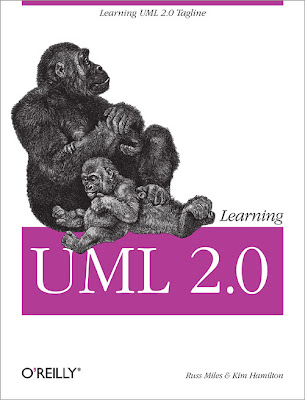Ebook Learning UML 2.0 / PDF
Ebook Learning UML 2.0 / PDF
What is UML?
Unified Modeling Language…
…is thestandard language for specifying, visualizing, constructing, and documenting software systems…
…as well as for business modeling and other non-software systems.
Why use UML?
Software project failure rate:
1994 (first CHAOS report): 84%
2001 (“extreme CHAOS”): 72%
2003 (most recent CHAOS): 69%
One solution: UML.
Modeling is an essential part in systems design.
UML design supports requirements for scalability, robustness, security, extensibility, and other characteristics, beforeimplementation in code renders changes difficult and expensiveto make.
It’s a (semi-)formal language.
It’s concise.
It’s comprehensive.
It’s scalable.
It’s built on lessons learned.
It’s the standard.
A Brief History of UML
1967: foundations of OOP –Nygaard, Goldberd, Stroustrup, Harel, Meyer…
1996: Rumbaugh, Booch, Jacobson –The Three Amigos
1997: UML 1.1, an OMG standard
1997-2003: UML 1.1, 1.3, 1.4, 1.5
2004: UML 2.0A Brief History of UML
Structure Diagrams
Class Diagram: classes, types, interfaces, and the relationships between them. (UML 1.x)
Component Diagram: important components within the system and the interfaces they use to interact with each other. (UML 1.x, revamped in 2.0)
Composite Structure Diagram: the internals of a class or component, and can describe class relationships within a given context. (UML 2.0)
Deployment Diagram: how the system is finally deployed in a given real-world situation. (UML 1.x)
Object Diagram: object instances of the classes defined in class diagrams in configurations that are important to the system. (informally UML 1.x)
Package Diagram: the hierarchical organization of groups of classes and components. (UML 2.0)
Class Diagram: classes, types, interfaces, and the relationships between them.
Ebook Learning UML 2.0 / PDF
What is UML?
Unified Modeling Language…
…is thestandard language for specifying, visualizing, constructing, and documenting software systems…
…as well as for business modeling and other non-software systems.
Why use UML?
Software project failure rate:
1994 (first CHAOS report): 84%
2001 (“extreme CHAOS”): 72%
2003 (most recent CHAOS): 69%
One solution: UML.
Modeling is an essential part in systems design.
UML design supports requirements for scalability, robustness, security, extensibility, and other characteristics, beforeimplementation in code renders changes difficult and expensiveto make.
It’s a (semi-)formal language.
It’s concise.
It’s comprehensive.
It’s scalable.
It’s built on lessons learned.
It’s the standard.
A Brief History of UML
1967: foundations of OOP –Nygaard, Goldberd, Stroustrup, Harel, Meyer…
1996: Rumbaugh, Booch, Jacobson –The Three Amigos
1997: UML 1.1, an OMG standard
1997-2003: UML 1.1, 1.3, 1.4, 1.5
2004: UML 2.0A Brief History of UML
Structure Diagrams
Class Diagram: classes, types, interfaces, and the relationships between them. (UML 1.x)
Component Diagram: important components within the system and the interfaces they use to interact with each other. (UML 1.x, revamped in 2.0)
Composite Structure Diagram: the internals of a class or component, and can describe class relationships within a given context. (UML 2.0)
Deployment Diagram: how the system is finally deployed in a given real-world situation. (UML 1.x)
Object Diagram: object instances of the classes defined in class diagrams in configurations that are important to the system. (informally UML 1.x)
Package Diagram: the hierarchical organization of groups of classes and components. (UML 2.0)
Class Diagram: classes, types, interfaces, and the relationships between them.
Ebook Learning UML 2.0 / PDF



0 commentaires: